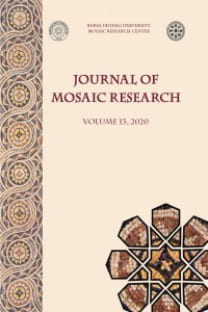Mértola Dini Kompleksi (Portekiz) Mozaiklerindeki Geometrik Temalar
Mértola yerleşimi, en erken İÖ 2. binyılın sonu veya İÖ 1. binyılın başlarına tarihlenmektedir. Demir Çağı olarakadlandırılan, muhtemelen İÖ 3. yüzyılda, yaklaşık 4 kilometre uzunluğundaki bir sur duvarıyla muhafazaedilmiştir. Bu, 173 dönümlük kuvvetlendirilmiş bir alana eşdeğerdir. Roma egemenliği döneminde Mirtylis şehrisikke basmış ve sur duvarları içinde bazı özel konutlar ve üretim alanları ile forum ya da kastellum gibi önemliyapıların bulunduğu önemli bir ticaret limanı olmuştur. İS 4. yüzyılda, Hıristiyanlık Roma İmparatorluğu‘nunresmi dini haline geldiğinde, Mértola'da önemli sivil mimarlık faaliyetleri gerçekleştirilmiştir: Nehrin yakınındabir kule ve cenaze törenleri için kullanılan bir bazilika ve mausoleum gibi dini tesisler inşa edilmiştir. Eskiforumun platformunda gelişen ve iki adet ihtişamlı baptisteriumu olan kutsal alanda mozaik kalıntıları tespitedilmiştir. Mértola'daki mozaikler için tarihleme unsurlarının kıtlığına karşın bunların 6. yüzyıla ait olduklarıdüşünülmektedir. Çünkü bu tarihlerde, muhtemelen Doğu Bizans’tan gelen beğeni ve moda etkisi ile toplumunüyeleri Grekçe yazılmış epitaphları ile birlikte gömülmüştür. Bu yüzyıl ve sonraki yüzyıl boyunca şehrinbanliyölerinde iki önemli mausoleum ve bir bazilika inşa edilmiştir. Forumda bir dizi dini yapı, Mértola'nınHıristiyan topografyasına işaret etmektedir.
Anahtar Kelimeler:
Mozaik, dini kompleks, Geç Antik, Mértola, Portekiz
The Geometric Themes in the Mosaics of the Religious Complex of Mértola (Portugal)
The Settlement of Mértola dates from at least the end of the second or early first millennium BC. In the so-calledIron Age, possibly in the third century BC, a walled enclosure with a total length of about 4 kilometres wasconstructed. This is equivalent to a fortified area of 173 acres. During the period of Roman domination, thecity of Mirtylis minted coins and was an important trading port with an important set of structures, such as theforum or the castellum, some private residences and production sites within its walls.In the late forth century AD, when Christianity became the official religion of the Roman Empire, importantcivil structures were built in Mértola, such as the tower near the river, and religious facilities such as funeralbasilicas and a mausoleum. The sacred area developed on the platform of the old forum where, together withtwo imposing baptisteries, the mosaic fragments were found.Despite the scarcity of dating elements for the mosaics in Mértola, it would appear that they belong to the sixthcentury, a historical period in which the members of the community were buried with their epitaphs written inGreek, possibly because of the influence of tastes and fashions from the Byzantine East. During this and the nextcentury, two important basilicas and a mausoleum were built in the suburbs of the city. On the forum, a set ofreligious buildings would therefore mark the Christian topography of Mértola.
Keywords:
Mosaic, religious complex, Late Antiquity, Mértola, Portugal,
___
- G. Åkerström-Hougen, 1974, The Calendar And Hunting Mosaics of The Villa of The Fal- Coner In Argos: A Study in Early Byzantine Iconography, Svenska Institutet I Athen, Stockholm.
- F. Baratte, 1978, Catalogue des Mosaïque Romaines et Paléochrétiennes du Musée du Louvre, Paris.
- H. Buschhausen, 1989, Mosaïques Byzantines de Jurdainie, Musée de la Civilisation Galoromaine de Lyon, Paris.
- J.E. Cirlot, 1982, Dicionário de símbolos, Barcelona.
- T. Ghalia, 1998, Hergla et les Mosaïques de Pavement des Basiliques Chrétiennes de Tunisie: Plan, Décore Et Liturgie, Tunis.
- T. Ghalia, 2001, “Ghalia, La Mosaïque Byzantine En Tunisie”, DossAParis 268, 67-77.
- P. Gouber, 1944, “Bizance et I’Espagne wisigothique (554-7II)”, REByz 2, 5-78.
- P. Gouber, 1945, P.“L’administration de I’Espagne byzantine”, REByz 3, 127-143.
- P. Gouber, 1946a, “Influences byzantine sur I’Espagne wisigothique”, REByz 4, 111-134.
- P. Gouber, 1946b, P. “L’administration de I’Espagne byzantine“, REByz 4, 70-110.
- I. Lavin, 1963, The Hunting Mosaics of Antioch and Their Sources: A Study of Compositional Principles In The Development of Early Mediaeval Style, Dumbarton Oaks Papers 17, 179-286.
- V. Lopes, 2003, Mértola na Antiguidade Tardia, Campo Arqueológico de Mértola, Mértola.
- V. Lopes, 2014, Virgílio Mértola e o seu território na antiguidade tardia (séculos IV-VIII), Huelva: Universidade de Huelva, Dissertação de Doutoramento, Disponívelem.
- J. M. B. Oleiro, 1992, “Corpus dos mosaicos romanos de Portugal, I, conventus scallabitanus. Conímbriga: Casa dos Repuxos”, Lisboa, IPM-MMC.
- M. Piccirillo, 1993, M. The Mosaics of Jordan, Amman.
- E. Veiga, 1983, E. Memórias das Antiguidades de Mértola, Edição Fac-Similada de 1880, Lisboa, Imprensa Nacional/Câmara Municipal De Mértola.
- J. Vizcaíno Sánchez, 2009, La presencia Bizantina en Hispania (siglos VI-VII): la documentación arqueológica, Murcia, Universidad de Murcia.
- M. Yacoub, 1970, Le Musée Du Bardo – Museée Antique, Tunis.
- M. Yacoub, 1995, Splendeurs Des Mosaïques de Tunisie, Tunis.
- ISSN: 1309-047X
- Başlangıç: 2008
- Yayıncı: Ululdağ Üniversitesi, Mozaik Araştırlmaları Merkezi
Sayıdaki Diğer Makaleler
Portekiz’de Yer Alan São Simão Roma Villası’ndan Mozaikler
Sónia VICENTE VICENTE, Ana Luísa MENDES
Ansião Belediyesi (Portekiz), Santiago de Guarda Anıtsal Kompleksi’ndeki Roma Villası Mozaikleri
Hispanik Meseta Norte’ninMozaikleri: Evreler, Atölyeler, Sanatsal Yönü
Fernando REGUERAS, Caridad SAN JOSÉ
Bracara Augusta’nın Roma Mozaikleri: Dekoratif Motiflerin Yeniden Okunması ve Yeniden Yorumlanması
Fátima ABRAÇOS, Licínia WRENCH
Abelterium: Casa da Medusa Villası ve Quinta do Pião’nun Geometrik Mozaikleri
Roma Mozaiklerinin İkonografisinde Doğu Batı’ya Karşı: Ortak Konulardan Seçilmiş Örnekler
